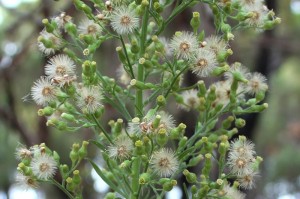Mare’s Tail
 Also called Horseweed or Canadian Fleabane, this is a new weed on the property. Throughout summer, I have been pulling up any that I find, but would have come across fewer than 20. I obviously missed this one and when I found it in the forest, it was taller than me and worryingly had already set seed. All the others I had pulled were just all leaf. Driving from Nannup to Balingup for the small farm field day, I noticed that the road verges were covered with the weed.
Also called Horseweed or Canadian Fleabane, this is a new weed on the property. Throughout summer, I have been pulling up any that I find, but would have come across fewer than 20. I obviously missed this one and when I found it in the forest, it was taller than me and worryingly had already set seed. All the others I had pulled were just all leaf. Driving from Nannup to Balingup for the small farm field day, I noticed that the road verges were covered with the weed.
Fleabane is regarded as one of the major difficult-to-control weeds in northern New South Wales and southern Queensland and has been declared as an emerging weed in Western Australia, prevalent along the south coast but spreading to other areas as well.
It is one of the most important weeds of dryland cropping due to its distribution and the difficulty with its control. It was initially a weed of roadsides, particularly where the road shoulders were sprayed with glyphosate (leaving bare soil on which the fleabane could germinate and flourish).v A 2009 survey by Western Australian Herbicide Resistance Initiative (WAHRI) in WA found fleabane mostly on roadsides and fence lines with its distribution into cropping paddocks predominantly around Esperance. The danger of this weed is greatly enhanced by the enormous number of seeds the plant can produce, an average of 60,000 seeds per weed is normal, with large plants producing up to 200,000 seeds.
In the USA, Canadian fleabane numbers increased with the change to no-tillage growing systems. It had previously occurred along roadsides and field edges but then rapidly colonised the uncultivated fields.
As the name suggests, Canadian fleabane works as a flea and insect repellent. According to 17th Century botanist and herbalist Culpeper, Fleabane helps with bites from ‘venomous beasts’ and its smoke can kill gnats and fleas. Can be dangerous for pregnant women. By 1994 scientific studies validated the plant’s use as an insecticide.

Facebook